
The 1912 United States presidential election was the 32nd quadrennial presidential election, held on Tuesday, November 5, 1912. Democratic governor Woodrow Wilson of New Jersey unseated incumbent Republican president William Howard Taft while defeating former president Theodore Roosevelt and Socialist Party nominee Eugene V. Debs.

The 1920 United States presidential election was the 34th quadrennial presidential election, held on Tuesday, November 2, 1920. In the first election held after the end of the First World War, and the first election after the ratification of the Nineteenth Amendment which gave equal votes to men and women, Republican senator Warren G. Harding of Ohio defeated Democratic governor James M. Cox of Ohio. It was the third presidential election in which both major party candidates were registered in the same home state. The others have been in 1860, 1904, 1940, 1944, and 2016, and the last time that the state was not New York. It was the first presidential election to have its results broadcast by radio.

The 1932 United States presidential election was the 37th quadrennial presidential election, held on Tuesday, November 8, 1932. The election took place against the backdrop of the Great Depression. The incumbent Republican President Herbert Hoover was defeated in a landslide by Democrat Franklin D. Roosevelt, the governor of New York and the vice presidential nominee of the 1920 presidential election. Roosevelt was the first Democrat in 80 years to simultaneously win an outright majority of the electoral college and popular vote, a feat last accomplished by Franklin Pierce in 1852, as well as the first Democrat in 56 years to win a majority of the popular vote, which was last achieved by Samuel J. Tilden in 1876. Roosevelt was the last sitting governor to be elected president until Bill Clinton in 1992. Hoover became the first incumbent president to lose an election to another term since William Howard Taft in 1912, the last to do so until Gerald Ford lost 44 years later, and the last elected incumbent president to do so until Jimmy Carter lost 48 years later. The election marked the effective end of the Fourth Party System, which had been dominated by Republicans. It was the first time since 1916 that a Democrat was elected president.

Charles Phelps Taft was an American lawyer and politician who served as editor of the Cincinnati Times-Star and owned both the Philadelphia Phillies and Chicago Cubs baseball teams. From 1895 to 1897, he served one term in the U.S. House of Representatives.
Law Preservation Party was the name used in the State of New York by the Prohibition Party during the early 1930s. The name change was done to affirm their support of the continuance of Prohibition in the United States in the face of widespread opposition which ended with the passing of the 21st Amendment in 1933.

David Sinton Ingalls was the US Navy's only flying ace of World War I, with six credited victories; thus he was the first ace in US Navy history.

The 1940 United States Senate election in Massachusetts was held on November 5, 1940, with Democratic incumbent David I. Walsh defeating his challengers.

The 1934 United States Senate election in Massachusetts was held on November 6, 1934. Democratic incumbent David I. Walsh was re-elected to a second consecutive term, the first Democrat ever to do so in the state, in a landslide over Republican Robert M. Washburn.
A Massachusetts general election was held on November 6, 1962, in the Commonwealth of Massachusetts.
A Massachusetts general election was held on November 8, 1960, in the Commonwealth of Massachusetts.

The United States Senate election of 1932 in New York was held on November 8, 1932. Incumbent Democratic Senator Robert F. Wagner was re-elected to a second term over Republican George Z. Medalie.

The 1928 United States Senate election in Connecticut was held on November 6, 1928. Incumbent Republican Senator George P. McLean was not a candidate for re-election. In his place, Republican State Senator Frederic C. Walcott won the seat against former U.S. Representative Augustine Lonergan.

The 1948 United States presidential election in North Carolina took place on November 2, 1948, as part of the 1948 United States presidential election. North Carolina voters chose 14 representatives, or electors, to the Electoral College, who voted for president and vice president.
A Massachusetts general election was held on November 4, 1952 in the Commonwealth of Massachusetts. Primary elections took place on September 16.

Elections were held to elect the New York City Board of Aldermen on November 5, 1929, in concert with other such contests as the Mayor, the Comptroller, the President of the Board of Aldermen, Borough presidents, County Sheriffs, and other miscellaneous questions.

The 1914 Iowa gubernatorial election was held on November 3, 1914. Incumbent Republican George W. Clarke defeated Democratic nominee John Taylor Hamilton with 49.31% of the vote.

The 1932 Wisconsin gubernatorial election was held on November 8, 1932. Incumbent Republican Governor Philip La Follette was defeated in the Republican primary, and in the midst of the Great Depression and nationwide voter dissatisfaction with the Republican Party, Democratic nominee Albert G. Schmedeman defeated Republican nominee Walter J. Kohler Sr. and Socialist nominee Frank Metcalfe with 52.48% of the vote. Schmedeman became the first Democrat to win a gubernatorial election in Wisconsin since George Wilbur Peck in 1892. Two years later, in 1934, La Follette would run for governor again and defeated Schmedeman, this time running with the Progressive Party.

The 1932 Missouri lieutenant gubernatorial election was held on November 8, 1932. Democratic nominee Frank Gaines Harris defeated Republican nominee James J. Barrett with 62.13% of the vote.

The 1904 Washington gubernatorial election was held on November 8, 1904.

The 1932 Illinois gubernatorial election was held on November 8, 1932. It saw the election of Democrat Thomas Donavan, who defeated incumbent Republican lieutenant governor Fred E. Sterling.



















